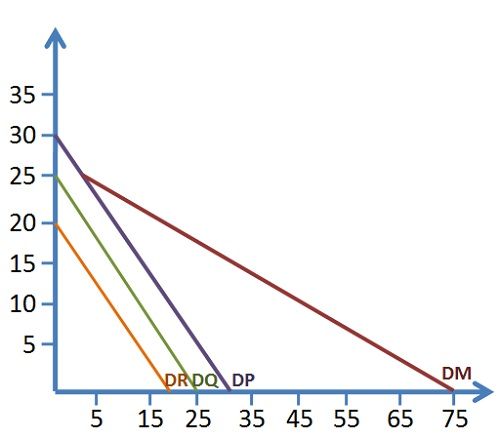Definition: The total quantity that all the individuals are willing to and are able to buy at a given price, other things remaining the same is called as Market Demand. In other words, Market Demand refers to the sum of individual demands for a product at a given price per unit of time.
What is Individual Demand? Individual demand refers to the quantity of a commodity demanded by an individual per unit of time, at a given price. The aggregate of individual demands for a product per unit of time constitutes the market demand. The market demand schedule and the curve can be obtained if the individual demand schedules or individual demand functions are known. Thus, the demand curve can be derived by adding up:
- Individual Demand Schedules
- Individual Demand Functions
Demand Curve Obtained from Individual Demand Schedules: Suppose, there are three consumers (P, Q, R) of commodity A, and their monthly demand schedules are given in the table below:
| Price of A (Rs.) | Quantity Demanded by P | Quantity Demanded by Q | Quantity Demanded by R | Market Demand |
|---|---|---|---|---|
| 30 | 0 | 0 | 0 | 0 |
| 25 | 5 | 0 | 0 | 5 |
| 20 | 10 | 5 | 0 | 15 |
| 15 | 15 | 10 | 5 | 30 |
| 10 | 20 | 15 | 10 | 45 |
| 5 | 25 | 20 | 15 | 60 |
| 0 | 30 | 25 | 20 | 75 |
The table shows individual demands of the three consumers at different prices of commodity A. The last column shows the market demand (sum of individual demands). On the basis of an individual and the market demand schedule, the demand curve can be obtained by plotting the market demand of commodity X against respective prices.
Demand Curve obtained from Individual Demand Functions: The demand curve can also be obtained by using the individual demand function. Suppose, the individual demand function of three consumers (P, Q, R) for commodity A are given as:
P’s Demand Function: DP = 75 – 10 PA
Q’s Demand Function: DQ = 50 – 7 PA
R’s Demand Function: DR = 25 – 5 PA
Given, the individual demand functions, the market demand function can be obtained by adding up all these individual functions. Thus,
DM= (75 – 10 PA) + (50 – 7 PA) + (25 – 5 PA) = 150 -22PA
This demand function can be converted into a market demand schedule by assigning the numerical value to PA. Once the schedule is obtained, the demand curve can be drawn by plotting the demand schedule.


Leave a Reply